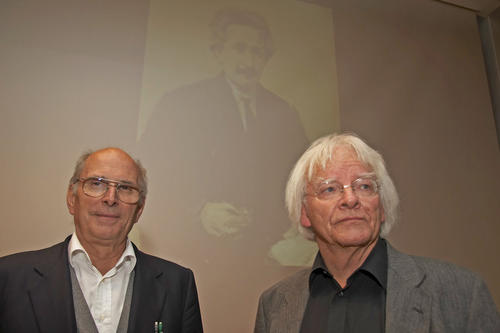4th Einstein Lecture Dahlem: Günter Dosch & Hans Specht
Musical perception – physics, neurophysiology, psychology
Nov 03, 2006
Prof. Dr. H. Günter Dosch (li.), Prof. Dr. Hans J. Specht: "Musik und Physik in Einklang bringen".
Image Credit: Bernd Wannenmacher
First held in 1986, the joint lecture on physics and music by Günter Dosch (Institut für Theoretische Physik, Universität Heidelberg) and Hans Specht (Physikalisches Institut, Universität Heidelberg) developed into regular lectures and grew into an independent research program with students. At first, the program focused on psychoacoustics, later on neurophysiology in cooperation with the neurological department of Heidelberg University Hospital. Meanwhile several publications on this topic have appeared from this working group. On November 3, 2006, they presented the 4th Einstein Lecture Dahlem.
Musical tones have a periodical time performance. The ear decomposes them into partials that form a harmonic series. Nevertheless the overall impression is an integral whole, characterized by pitch and timbre. For a periodic tone consisting only of few components it depends on the type of listener, the overall impression can be preserved (key tone listener), or it is substituted by the perception of single components (overtone listener).
For some time now Dosch and Specht are trying to reveal the special role of periodic tones in musical perception by means of psychoacoustical and neurophysiological methods. When conducting a survey among a great number of professional and amateur musicians as well as non-musicians, they found significant structural and functional differences in the primary auditory cortex of the brain which are substantially correlated with musical talent and long-term training. The above-mentioned types of hearers show a dominance of the left or right auditory cortex. The musical consequences of the special role of harmonic series and their processing range from Rameau’s “basse fondamentale” to the eventual choice of instruments by professional musicians depending on the type of listener.
Hans J. Specht, born 1936, studied physics in Munich and Zurich. After his doctorate in Munich in 1964, he became a researcher first at AECL in Canada and later at Technische Universität München. In 1973, he became Professor for Experimental Physics at Universität Heidelberg. He initially focused on atomic and nuclear physics. In 1982, he moved on to high energy heavy ion physics. He completed several research stays at CERN in Geneva and was Scientific Director at Gesellschaft für Schwerionenforschung in Darmstadt (Society for heavy ion research). Since 2000 he is a member of the Heidelberg Academy of Sciences and Humanities and in 2004 he reached the status of an emeritus.
Günter Dosch, born 1936, studied physics in Heidelberg and Paris. He completed his doctorate in 1963 in Heidelberg on theoretical physics of elementary particles. His main focus is the theory of the strong interaction. He worked at CERN in Geneva, MIT in the USA and in Karlsruhe, Germany. In 1969, he became Professor for Theoretical Physics at Universität Heidelberg. After reaching the status of an emeritus in 2002, he concentrates on philosophical questions within physics of elementary particles, and, increasingly, on neurophysiology. In 1996, he became a member of the Heidelberg Academy of Sciences and Humanities and was the secretary of their mathematical and scientific class from 2003-2006.

